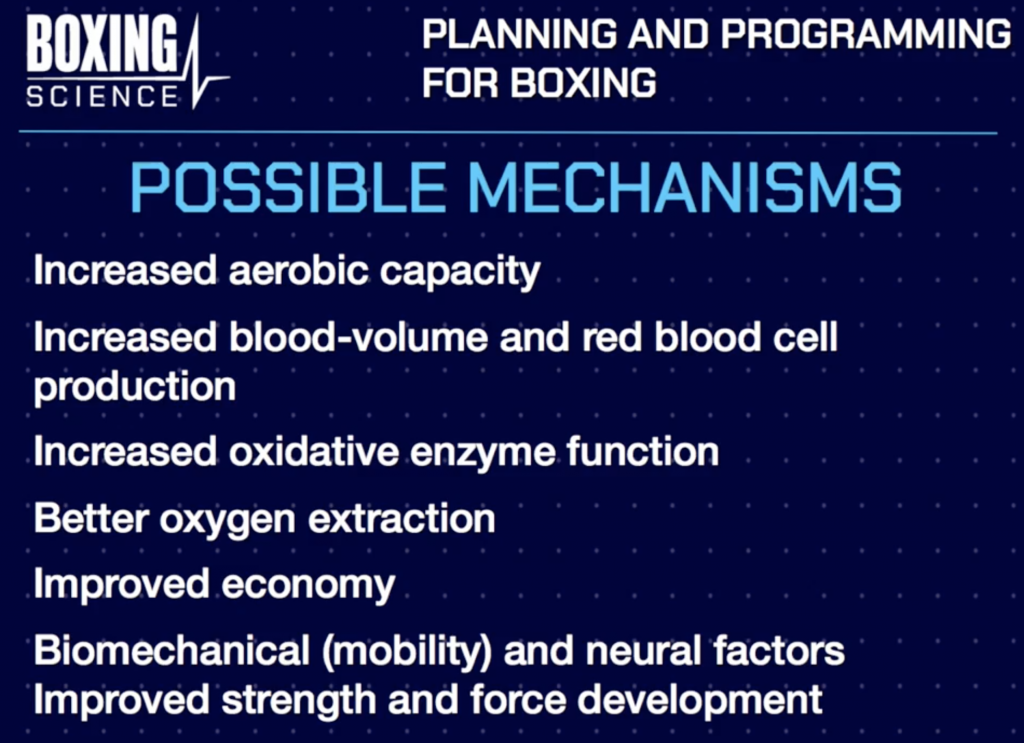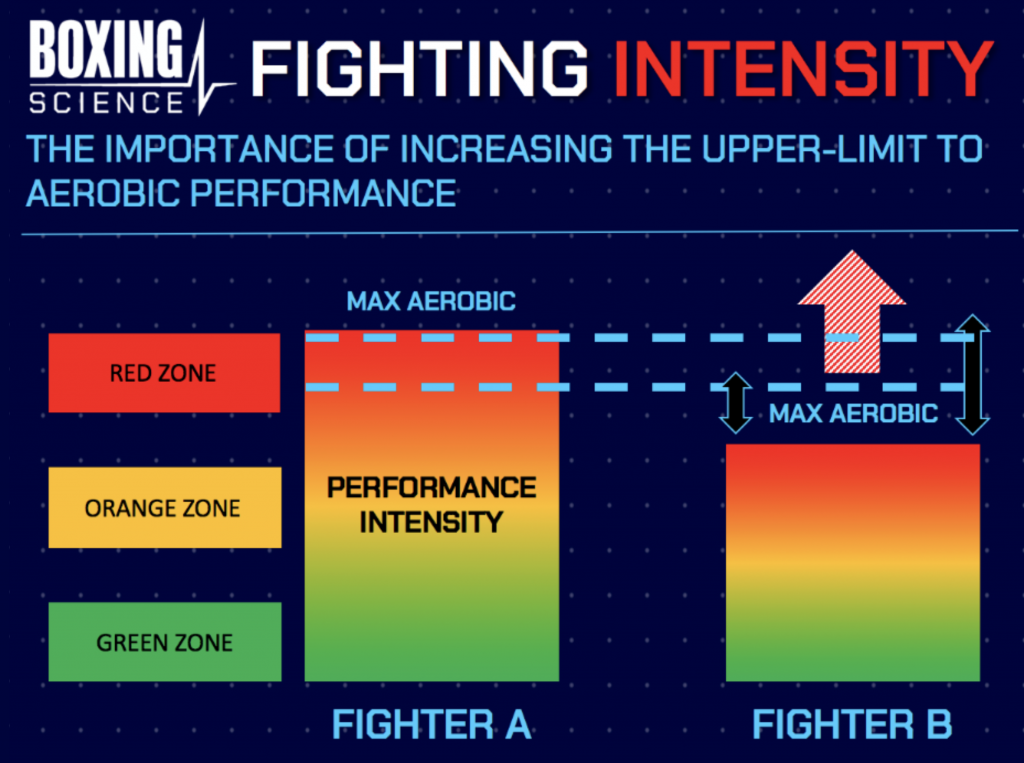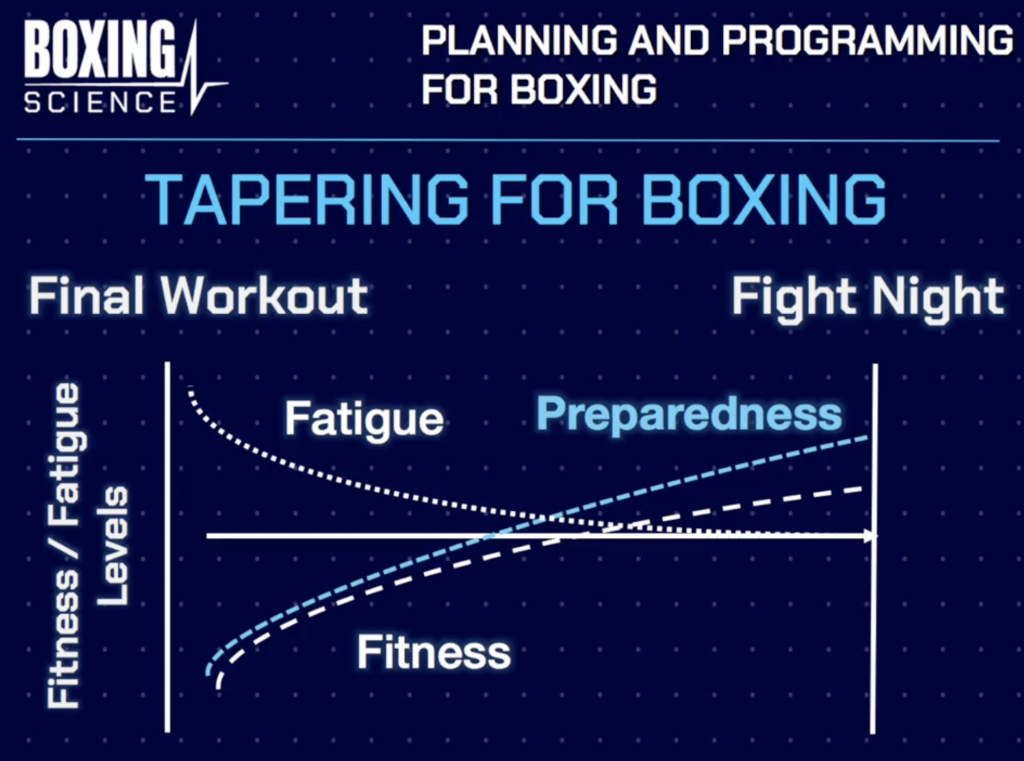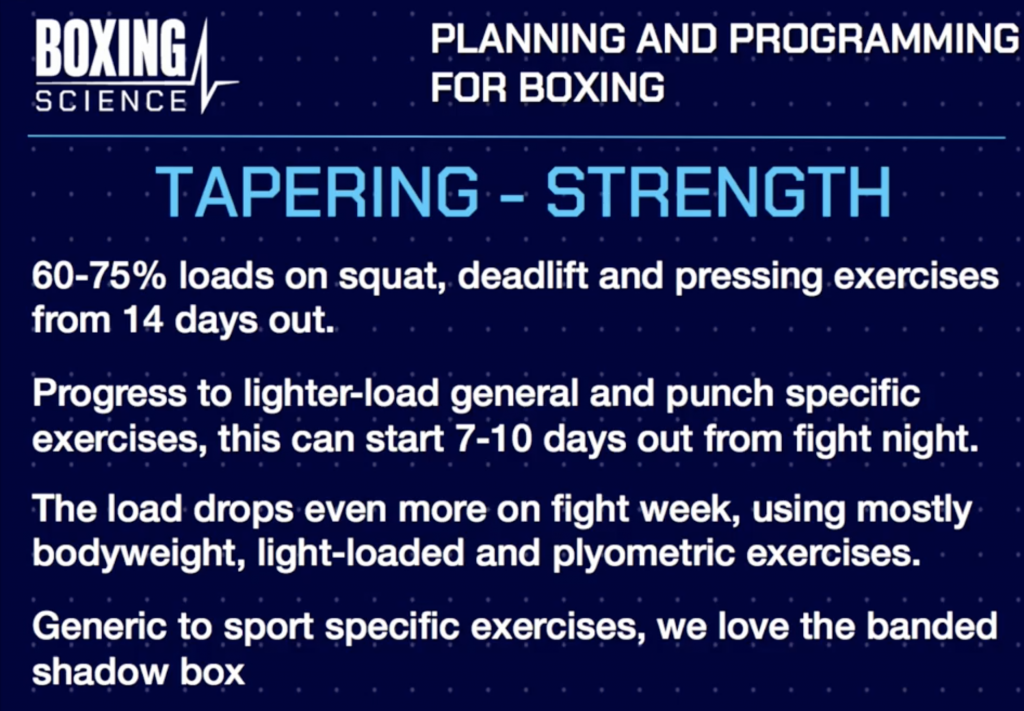PROGRAMMING FOR BOXING: THE TAPER
The taper is a vital component of any training program leading into competition.
A correctly planned taper can allow the athlete to achieve peak performance physically and psychologically and realise the adaptations gained during training camp.
A poorly executed taper, however, can unravel all of the hard work performed across a training camp, leaving the athlete fatigued, stale and potentially in a burned out state which ultimately make it impossible for the athlete to reach peak performance.
Considering the high training loads associated with fight camp combined with the pressures of making weight, the taper should be a top priority for any coaches/sport science practitioners involved in boxing.
Therefore the main points this article will discuss are as follows:
An introduction to tapering and what the process entails, specifically.
The benefits of the taper as reported in the scientific literature and how these benefits can help with performance in the ring.
The nuances of tapering for boxing and how we implement tapering strategies for our boxers at Boxing Science.

WHAT IS A TAPER?
Tapering can be considered as a programming strategy implemented to achieve peak physical and psychological condition via the dissipation of fatigue accumulated during training camp prior to competition.
The taper is generally characterised by a reduction in training volume whilst maintaining or slightly increasing training intensity.
As stated previously there are generally two main aims of a taper:
Achieve peak performance for a specific event/competition.
Promote the dissipation of fatigue that has been accumulated over a hard training camp and therefore help the athlete realise adaptations obtained during this training period.
THE TYPES OF TAPER
There are generally four types of taper that are discussed in the scientific evidence and that are applied, practically, depending on the sporting context.
The types of taper include:
Linear Taper: This is comprised of a systematic, linear reduction in training load
Step Taper: The training load is reduced suddenly by a constant amount.
Exponential – Fast: Training load is reduced in a systematic, exponential fashion at a fast rate (fast decay)
Exponential – Slow: The training load is reduced in a systematic, exponential manner but at a slow rate (slow decay).
What is the best tapering model to use?
This is a difficult question and will ultimately depend on the athlete and his/her sporting context. Indeed, it may take some trial and error to determine what type of taper the athlete responds best to.
That said, the existence evidence offers useful insight in terms of a starting point for tapering strategies.
The recommendations based on the evidence are as follows:
An exponential taper is better than a step taper.
A fast exponential protocol is superior to a slow decay exponential tapering strategy.
The optimal duration of a taper is between 14 and 21 days.
The longer training/intensification period, the longer the duration of a taper should be.
A reduction in training volume/load between 40-60% across the tapering period. Reductions in training volume below this range are considered insufficient to significantly remove fatigue accumulated during training camp whilst greater percentages reductions in training load are seen as excessive and may induce a detraining effect prior to competition.
Reductions in intensity are not recommended and this training variable should be maintained at least or even slightly increased during the taper period. This means that training load should be reduced primarily through volume during a taper rather than intensity.

ALTERNATIVE TAPERING STRATEGIES?
There is evidence to suggest that a two phased or double peaked taper may be beneficial in some instances.
This entails an initial advanced decrease in training load followed by a slight increase prior to competition.
It must be noted that the slight increase is an increase relative to the training volume of the taper period specifically and does not mean that th athlete is exposed to training loads similar to that performed in the middle of a hard training camp.
The rationale behind this strategy is athletes will have increased tolerance to training due to the initial reduction in training volume and will respond positively to a slight increase in training load prior to competition, almost experiencing a more long term potentiation effect.
In terms of real world application of the taper, detailed reports of Olympic athlete’s tapering period are available.
The main takeaway from these is that training volume tends to fluctuate during a taper but display a general trend towards reduction. This essentially means that training load is not necessarily decreased on a session by session basis but instead, over the tapering period, exhibits a net reduction.

BENEFITS OF A TAPER
There are numerous proposed benefits of an appropriately planned and executed tapering strategy.
Benefits of the taper maybe categorised into Metabolic and Cardiovascular, Neuromuscular, Hormone Concentrations and Psychological.
These changes aid in the attainment of peak performance come competition time and in a sport such as boxing, where the margins between winning and losing can be so small, these percentage gains in prior to competition can make a big difference on fight night.
METABOLIC AND CARDIOVASCULAR
Seeing as the tapering strategy was originally introduced to promote optimal performance in endurance based athlete, the positive changes in cardiovascular function and thus aerobic capacity have been extensively investigated.
A correctly executed taper can induce improvements in VO2 max or at least maintain levels of aerobic capacity.
There has also been a general consensus throughout the research that economy of movement is improved as a result of the taper. This is mainly attributed to improved mitochondrial content in the muscle which can help buffer lactate and thus prolong the stage at which fatigue begins to set in.
Positive changes in movement economy are based on the assumption that the mode of training performed during the taper remains specific to the competition or event at the athlete is preparing for.
Increased extraction of oxygen for a given blood flow by the muscle cells has also been reported following a taper period which means more energy can be produced aerobically thus limiting glycolysis and accumulation of lactate.
Aerobic capacity maybe further increased as a result of greater red blood cell production and blood volume following a taper.
Progressively increased muscle glycogen stores during the taper. 17% increase after four day taper and 25% increase following 8 day taper has been reported.
Peak blood lactate i.e the highest lactate value that can be reached during performance, has been shown to increase as a result of a taper. This displays an improvement in the athlete’s ability to work at high intensities.
BIOCHEMICAL, NEUROMUSCULAR, HORMONAL & PSYCHOLOGICAL
Biochemically, the main improvement following a taper is a reduction in creatine kinase concentration which is a marker of muscle damage.
In terms of neuromuscular performance a tapering period has been shown to improve muscular strength and power.
Hormonal concentrations tend to display greater levels of testosterone with reduced levels of cortisol, suggesting less of a catabolic state following a taper period which reduces the chances of burnout and injury.
Psychologically the level of perceived exertion at a given intensity has been shown to decrease as well as positive changes in mood state.

BENEFITS OF TAPERING AND BOXING
So far this article has discussed, in considerable detail, the science behind the taper and the associated benefits of an effective tapering strategy.
But what are the implication of these benefit of boxing performance?
Firstly, through our own research as well as empirical research on the physiological demands of boxing, we know that aerobic capacity sets the ceiling of performance and ultimately dictates the athlete’s ability to repeat and recover form high intensity efforts in the ring.
Therefore, improvements in VO2 max following a taper will enable boxers to push the pace come fight night, expose the weaknesses in their opponent and have have enough energy in the tank to capitalise on mistakes made by their opponent.
These improvements in aerobic capacity are supplemented by positive adaptations in lactate kinetics, reducing the onset of fatigue at the muscular level which will help the athlete to maintain high power outputs and solid technique over the 12 rounds if necessary.

Acute Improvements in muscle strength and power will enable boxers to produce large amounts of force in a short period of time and thus maximise punch impact. These improvements will also help boxers react explosively to the opponents mistakes or movements, thus creating more opportunities for punishing counter punches.
Reduced concentrations of creatine kinase and therefore muscle damage will improve mobility and dexterity which will have a positive impact on the transmission of force from foot to fist as well as movement fluidity when evading punches from the opponent.
A catabolic (breaking down) environment can be of particular concern with boxers given the high training loads and common struggles with making weight. This can have a negative impact on recovery, sleep quality and overall mood, therefore reduced levels of cortisol concentration, as seen following a taper can maximise the boxer’s restoration, allowing him or her to realise the adaptations achieved during training.
Increased testosterone concentration, decreased ratings of perceived exertion at a given intensity and improved mood can be derived from the taper and will increase a boxer’s confidence in his/her physical condition as the fight approaches.

TAPERING FOR BOXING: PRACTICAL APPLICATIONS
Due to the obvious performance benefits that can be derived from a taper, we view this period as a top priority for our programs at Boxing Science.
As mentioned before, the margins between winning and losing are so fine in boxing and therefore a correctly judged taper is pivotal.
A mismanaged taper i.e too much training, too close to competition or if the bulk of our training is too far away from competition this can have considerable negative effects of the athletes physical condition can potentially undo all of the hard work endured during training camp.
Thus, precision is necessary.

BOXING SCIENCE TAPERING STRATEGY
We implement tapering strategies for conditioning and strength training at boxing science simply because these are two different stimuli, from which the boxers recovers differently and at a different rate.
These strategies will often coincide with and compliment the technical training load which emphasises the importance of a team based approach to the taper to ensure the fighter is in the best position physically, mentally, technically and tactically to perform at his or her best on fight night.
Our tapers will also differ depending amateur or professional status due to more frequent bouts in a shorter period of time associated with amateur competition.
STRENGTH TAPER
Strength session during the taper will largely consist of fast, explosive movements working on speed-strength qualities.
A considerable amount of punch specific work is performed during the taper phase as these can provide acute strength and power gains that will directly transfer to the punching action.
Explosive medicine ball exercises are usually staples of the strength tapering strategy along with landmine punch throws and medicine ball punch throws.
These exercises facilitate the recruitment of fast twitch muscle fibres and serve to really fire up the nervous system as fight night approaches which can maximise the nervous systems ability to produce high levels of force in a short period of time.
These types of exercises askew particularly prevalent during fight week. Prior to fight week the taper is initiated with a reduction in load to about 60-75% of 1RM on the key lifts, ensuring to maintain speed and maximal intent whilst incorporating some of the more explosive and punch specific action mentioned previously and shown in the video below.
The load and emphasis on the key strength lifts will decrease even more as the weeks progress with a noticeable shift from general strength training methods to more specific training modalities.
Additionally, mobility around the upper body, primarily thoracic rotation and shoulder mobility is prioritised.

CONDITIONING TAPER
The conditioning taper is usually longer in duration compared to the strength taper as our conditioning seession to be more stressful on the boxer. A gradual reduction in conditioning training load usually begins three weeks out from fight night.
We aim to maintain or slightly increase the intensity of our conditioning sessions whilst gradually reducing the volume over the tapering period.
This is done through the use of short, high intensity efforts for low reps.
Examples are 10 seconds maximal sprints, tabata intervals and 30-15 intervals.
With the tapering strategy for conditioning it is important to consider the type of conditioning that has been used throughout training camp.
For example if longer intervals have been used predominately during training camp e.g 2, 4 and 8 minute intervals, then short, max effort sprint may be too intense for the athlete and may increase the likelihood of injury whilst inducing further fatigue effects.
This sudden increase in intensity may be demonstrated by the speeds displayed during each type of interval i.e longer intervals are typically ran at 15 and 16 km/hr whereas during shorter intervals our boxers can achieve speeds of 25-28 km/hr. This represent an extreme increase in intensity and therefore mechanical stress.
An appropriate tapering strategy having performed longer running intervals for the majority of camp would be the use of tabatas (20s on : 10s off) or 30s on : 15s off, which allow for a less drastic increase in intensity whilst still exposing the athlete to higher speeds.
For more information around our strength and conditioning taper strategies take a look at our Boxing Science memberships features workshops that focus on our tapering strategies for both amateur and professional boxing: https://boxingscience.co.uk/boxing-science-membership/
ARTICLE SUMMARY
The taper is an important part of any training program and should be planned with as much precision as possible.
The taper can be considered a strategic reduction in training load prior to competition in order to achieve peak physical, mental and tactical performance.
There are four types of taper: Step, Linear, Exponential – Fast Decay and Exponential – Slow Decay.
The taper is characterised by a reduction in training volume whilst maintaining or slightly increasing intensity.
A well executed taper can induce favourable changes in aerobic capacity, lactate kinetics, neuromuscular function, hormonal concentrations and ratings of perceived exertion which can have a positive impact on boxing performance.
At Boxing Science we use differing taper strategies for conditioning and strength training as these impose different stimuli on the boxer and therefore require different rates of recovery.
